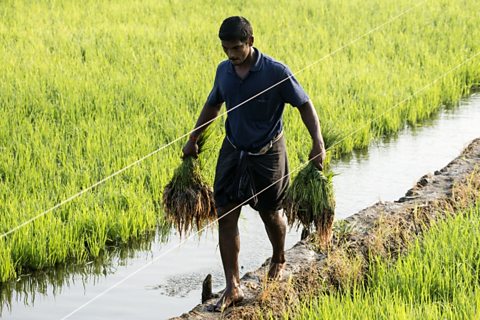Climate change
Human activities are causing an increase in the amounts of greenhouse gasThe gases responsible for global warming - carbon dioxide, methane, nitrous oxide and CFCs (chlorofluorocarbons). in the atmosphereThe layers of gases that surround the Earth. The important gases in the atmosphere are nitrogen, oxygen and carbon dioxide.. The table shows some common sources of carbon dioxide and methane.
| Gas | Human causes |
| Carbon dioxide | Burning fossil fuels |
| Methane | Cattle farming |
| Gas | Carbon dioxide |
|---|---|
| Human causes | Burning fossil fuels |
| Gas | Methane |
|---|---|
| Human causes | Cattle farming |

Enhanced greenhouse effect
The concentration of carbon dioxide in the atmosphere has increased in the last 200 years.
The extra carbon dioxide is causing an enhanced greenhouse effectThe retention of heat in the atmosphere caused by the build-up of greenhouse gases., greater than would happen naturally. There is a correlationA relationship between two sets of data, such that when one set changes you would expect the other set to change as well. between the increase in atmospheric carbon dioxide concentration and temperature change - as the concentration of carbon dioxide has increased, the global average temperature has generally increased too.
Climate change
The climateAverage weather conditions over longer periods and over large areas. describes the average weather over a long time and over a large area. The enhanced greenhouse effect is leading to climate changeThe long-term alteration of weather patterns.. The effects of this include:
- glacierA slow-moving ice mass, formed over a long period from compacted snow. and polar ice melting
- sea levelsA measure of the average height of the sea's surface. rising
- rainfall changing, producing floodsAn excess of water that does major damage to a region. or droughtA long period of low rainfall that creates a major shortage of water.
- habitatA place where plants, animals and microorganisms live. changing
Question
Suggest two reasons why climate change leads to rising sea levels.
Water from melting glaciers and polar ice enters the oceans. As the Earth's temperature increases, seawater warms up and expands.
There are international treatyA formal agreement between two or more countries. aimed at reducing the emissionsSubstances that are given off, especially in the form of gas. of carbon dioxide and other greenhouse gases. However, even if these emissions fell significantly, it would take a long time for the Earth's temperature to stabilise and then decrease. In the meantime, there are ways to mitigateTo make less severe or unpleasant. the effects of climate change. These include:
- building flood defences to manage floods from rivers and seas
- building irrigationThe channelling of water from rivers and streams to fields in order to help crops grow. systems to provide water in droughts
- planting different crops, better adapted to a new climate
These steps are expensive, need to be on a large scale, and may themselves harm the environmentThe immediate surroundings in which people live, or the natural world such as the land, air or water..